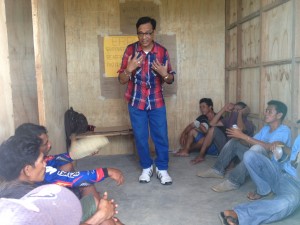ESTANCIA, ILOILO — “Ang pagiging tatay indi lang sa pangalan. Ang mga tatay katuwang sa panimalay kag sa pagpadako sa mga bata (Being a father is not just a term. Fathers are partners in running the households and bringing up the children),” said Ronnie Fuentes, 36, father of three children.
Ronnie, one of the occupants of the bunkhouses for typhoon and oil spill victims in Barangay Gogo, Estancia, Iloilo made this reaction after attending a “session for fathers” held right at the bunkhouses recently.
Being the only one who earns a living for the family, Ronnie, a fisherman, admitted he sometimes forget that he has also a responsibility to fulfill as a husband and a father.
“Maayo kay may lecture nga pareho sini. Damo gid kami natun-an. Nadugangan ang amon nabal-an parte sa amon mga obligasyon bilang tatay (Good thing there is a lecture like this. We have learned a lot about our obligations as fathers),” he added.
The activity was part of the advocacy initiated by the Child Protection Working Group for Typhoon Yolanda survivors, which is led by the DSWD and co-led by Child Fund.
“But aside from child protection, the group is also looking at gender-based violence in which men plays vital role thus session for men using Erpat module,” explained Josie Cambel, Regional Training Specialist II.
‘Men talking to men’
At least 35 fathers attended the lecture conducted by a team composed of mostly men from the DSWD regional office, the Provincial Social Welfare and Development Office (PSWDO) and the Empowerment and Reaffirmation of Paternal Abilities Training (ERPAT) at the Estancia bunkhouses.
During the activity it was noticed that the fathers are more participative when a man is sharing in front of them.
“Lain gid ila reaction kung lalaki ang nagahambal sa tunga. Mas maka-relate sila, ilabi na kung ang speaker naga-istorya base mismo sa ila eksperyensya, naga-tango gid sila dayun (They have a different reaction when a man is speaking in front of them. They can relate better, especially if the speaker tells them his own experiences, they would nod in affirmation),” said Eduardo Guevarra, Social Welfare Officer III and Focal Person on Women, Family and Community of the DSWD 6.

Fathers were made to differentiate “sex” from “gender,” identify the roles of both men and women and taught how to be more gender sensitive.
In his lecture, DSWD regional accountant Hector Roldan Provendido, an advocate on violence against women, emphasized on men that they should treat their wives well because staying at home taking care of the children and looking after the family’s needs is not an easy task.
If the husband has to pay his wife for every work that she does at home, Provendido said the husband’s daily earnings would not be even enough to pay her day’s work.
“Medyo nahinalian man sila nga amo gali na ka dako ang bayran nila sa ila asawa kung kwentahon ang tanan nga ginaobra nila sa sulod sang balay. Pero naintindihan nila nga ang obra sang asawa indi mahapos (They were quite surprised that they have to pay that big if they will pay their wives every work they do. But they understood that it’s not easy being a housewife),” he explained.
Guevarra said domestic violence happens because many men, who are often tagged as the perpetrators, still believe that they are superior than women.
John Calidguid, focal person of Erpat of the DSWD central office, said abuses and domestic violence happen at home because many men have not realized their real role in their family. “What they know is that they are the father and they have to provide for their family.”
With the help of ERPAT, he said they are hoping that men will become more informed and violence in homes, which mostly affect children, will lessen if not totally eradicated.
Child’s rights and protection in bunkhouses
Among the highlights of the activity are the sessions with children. There were art classes, story telling and lectures on the Rights of a Child conducted by volunteers from Unicef and World Vision International.
“Nalipay kami nga damo ang nagabulig sa amon kag wala kami maano sang bagyo. Pero nasuboan man kami kay naguba ang amon balay kag mga gamit kag ang amon eskwelahan. Indi kami makahampang sang maayo diri sa bunkhouse kag indi kami makalagaw-lagaw (We are happy that many are helping us and we are safe. But we are also sad because our house was destroyed together with our things and our school, too. We cannot play well and move around freely inside the bunkhouse,” said Kyla, 10.
Children were made to express their thoughts, feelings and dreams in the form of drawing, painting or poster.
Meanwhile, Cambel emphasized during her session with the mothers how to be resilient during disasters. She added resiliency should not be practiced only during typhoons but even before it or after it.
“Dapat may ara kita preparatory measures. Indi lang kita maghulag kung ara na (We should have preparatory measures. We should not only react when it is already there),” she said. The preparatory measure, she added, include prevention of abuses, especially on children, even inside the evacuation centers.
With this, she advised mothers to always keep an eye on their children, especially girls. Since one unit in the bunkhouse has only one room, she said the mothers should sleep with their daughters.
Other groups that also participated in the activity for fathers, mothers, and children (grouped according to ages) were Community and Family Services International (CFSI), International Organization for Migration, United Nations Population Fund, and the local government of Estancia.
At present, there are 69 families or a total of 313 persons living in the bunkhouses. Of the 313 individuals, 157 are male and 156 are female. Seventeen (17) of the families are beneficiaries of the Pantawid Pamilyang Pilipino Program./dswd6/Wenna Berondo-Bendol
